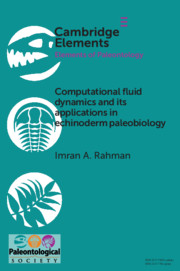Refine search
Actions for selected content:
58 results
Enhanced milk preservation during long-distance transportation: a numerical study of immersed evaporator system
-
- Journal:
- Journal of Dairy Research , First View
- Published online by Cambridge University Press:
- 25 September 2025, pp. 1-9
-
- Article
- Export citation
Mean flow data assimilation using physics-constrained graph neural networks
-
- Journal:
- Data-Centric Engineering / Volume 6 / 2025
- Published online by Cambridge University Press:
- 25 September 2025, e48
-
- Article
-
- You have access
- Open access
- HTML
- Export citation
A comparative study of aerodynamic characteristics of conventional and multi-lobed airships
-
- Journal:
- The Aeronautical Journal / Volume 129 / Issue 1339 / September 2025
- Published online by Cambridge University Press:
- 21 May 2025, pp. 2435-2459
-
- Article
-
- You have access
- Open access
- HTML
- Export citation
Study of brownout prediction of helicopters based on the analysis of ground effect flow field eigen quantities
-
- Journal:
- The Aeronautical Journal / Volume 129 / Issue 1338 / August 2025
- Published online by Cambridge University Press:
- 28 April 2025, pp. 2330-2353
-
- Article
- Export citation
7 - Solving differential equations
- from Part I - Areas of application
-
- Book:
- Quantum Algorithms
- Published online:
- 03 May 2025
- Print publication:
- 24 April 2025, pp 111-129
-
- Chapter
-
- You have access
- Open access
- Export citation
Hydrogen reaction rate modeling based on convolutional neural network for large eddy simulation
-
- Journal:
- Data-Centric Engineering / Volume 6 / 2025
- Published online by Cambridge University Press:
- 10 February 2025, e11
-
- Article
-
- You have access
- Open access
- HTML
- Export citation
Fundamental considerations in the design and performance assessment of propulsive fuselage aircraft concepts
-
- Journal:
- The Aeronautical Journal / Volume 129 / Issue 1333 / March 2025
- Published online by Cambridge University Press:
- 28 November 2024, pp. 762-787
-
- Article
-
- You have access
- Open access
- HTML
- Export citation
Comparing flow-based and anatomy-based features in the data-driven study of nasal pathologies
-
- Journal:
- Flow: Applications of Fluid Mechanics / Volume 4 / 2024
- Published online by Cambridge University Press:
- 25 April 2024, E5
-
- Article
-
- You have access
- Open access
- HTML
- Export citation
Using graph neural networks for wall modeling in compressible anisothermal flows
-
- Journal:
- Data-Centric Engineering / Volume 5 / 2024
- Published online by Cambridge University Press:
- 10 April 2024, e10
-
- Article
-
- You have access
- Open access
- HTML
- Export citation
Reliability assessment of off-policy deep reinforcement learning: A benchmark for aerodynamics
-
- Journal:
- Data-Centric Engineering / Volume 5 / 2024
- Published online by Cambridge University Press:
- 25 January 2024, e2
-
- Article
-
- You have access
- Open access
- HTML
- Export citation
Bespoke stability analysis tool in next-generation computational fluid dynamics solver
-
- Journal:
- The Aeronautical Journal / Volume 128 / Issue 1324 / June 2024
- Published online by Cambridge University Press:
- 23 November 2023, pp. 1164-1182
-
- Article
-
- You have access
- Open access
- HTML
- Export citation
11 - Case Studies on Hard Coating Design
-
- Book:
- Computational Design of Engineering Materials
- Published online:
- 29 June 2023
- Print publication:
- 29 June 2023, pp 370-401
-
- Chapter
- Export citation
Modeling the wall shear stress in large-eddy simulation using graph neural networks
-
- Journal:
- Data-Centric Engineering / Volume 4 / 2023
- Published online by Cambridge University Press:
- 09 March 2023, e7
-
- Article
-
- You have access
- Open access
- HTML
- Export citation
Compressibility corrections to extend a smooth local correlation-based transition model to transonic flows
-
- Journal:
- The Aeronautical Journal / Volume 127 / Issue 1313 / July 2023
- Published online by Cambridge University Press:
- 01 March 2023, pp. 1141-1170
-
- Article
-
- You have access
- Open access
- HTML
- Export citation

Computational Aerodynamics
-
- Published online:
- 12 August 2022
- Print publication:
- 01 September 2022
Fuel burn evaluation of a transonic strut-braced-wing regional aircraft through multipoint aerodynamic optimisation
-
- Journal:
- The Aeronautical Journal / Volume 127 / Issue 1308 / February 2023
- Published online by Cambridge University Press:
- 10 June 2022, pp. 305-329
-
- Article
-
- You have access
- Open access
- HTML
- Export citation

A Unified Computational Fluid Dynamics Framework from Rarefied to Continuum Regimes
-
- Published online:
- 13 May 2021
- Print publication:
- 10 June 2021
-
- Element
- Export citation
A novel cleanliness control method for disk amplifiers
-
- Journal:
- High Power Laser Science and Engineering / Volume 8 / 2020
- Published online by Cambridge University Press:
- 28 December 2020, e45
-
- Article
-
- You have access
- Open access
- HTML
- Export citation

Computational Fluid Dynamics and its Applications in Echinoderm Palaeobiology
-
- Published online:
- 30 October 2020
- Print publication:
- 19 November 2020
-
- Element
- Export citation






